Abstract
Infectivity of Bacteroides asaccharolyticus (formerly B. melaninogenicus subsp. asaccharolyticus; see S. M. Finegold and E. M. Barnes, Int. J. Syst. Bacteriol. 27:388--391, 1977) was dependent on the presence of a second organism. An infective consortium consisting of B. asaccharolyticus and Klebsiella pneumoniae was defined. Neither organism was infective alone, but the Klebsiella could be replaced by organisms of a number of different genera. The nature of the infection appeared to be determined by the length of the lag period preceding the initiation of growth of B. asaccharolyticus. A rapid onset of growth led to the severe spreading form of the disease, whereas a slow initiation of growth resulted in the formation of a localized, self-limiting abscess. B. asaccharolyticus depends on the second or "helper" organism to produce a required growth factor which is not present at the inoculation site. The growth factor was shown to be succinate which was able to replace the hemin requirement. The dependency on succinate produced by K. pneumoniae was demonstrated in agar medium, in liquid culture, and in the infectivity assay. Any organism which produced succinate was able to stimulate growth of B. asaccharolyticus on agar medium and could replace K. pneumoniae as a member of the infectious consortium. The need for the second organism could be eliminated by inoculating B. asaccharolyticus together with agar-immobilized succinate or hemin.
Full text
PDF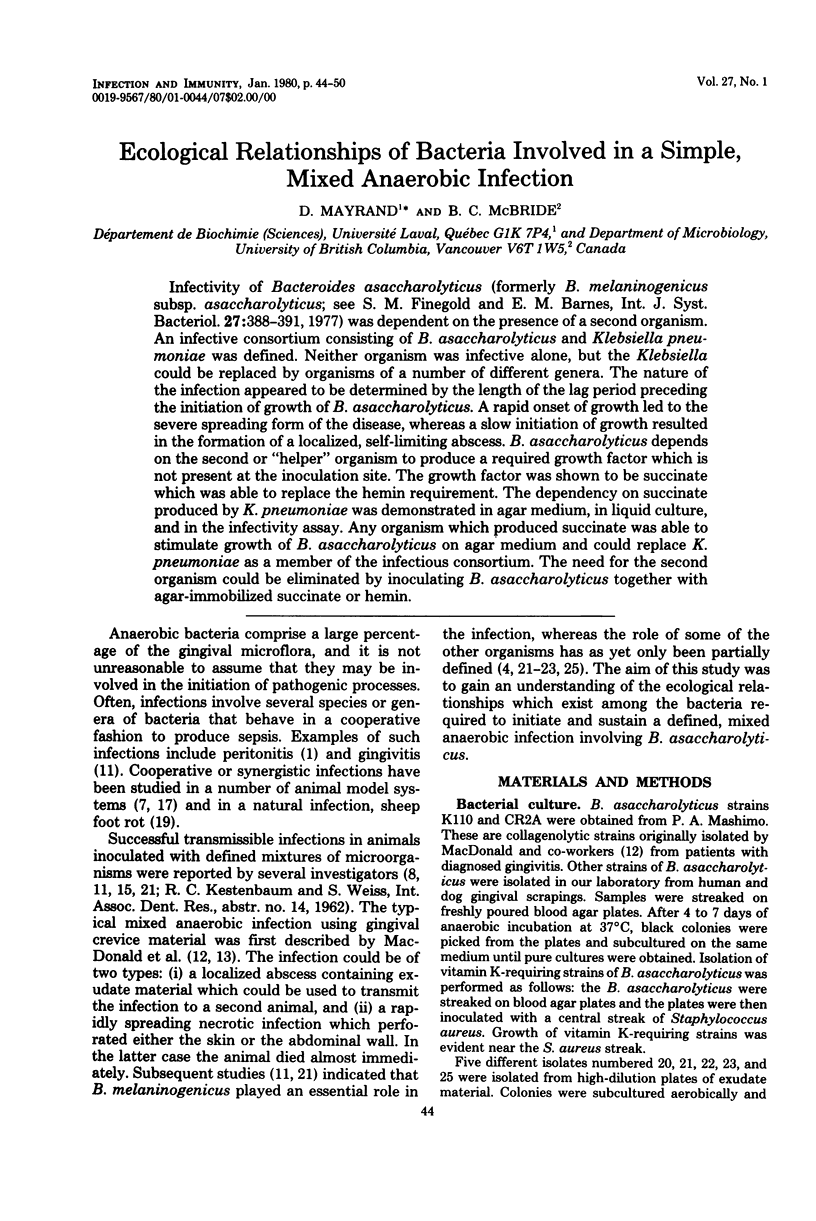

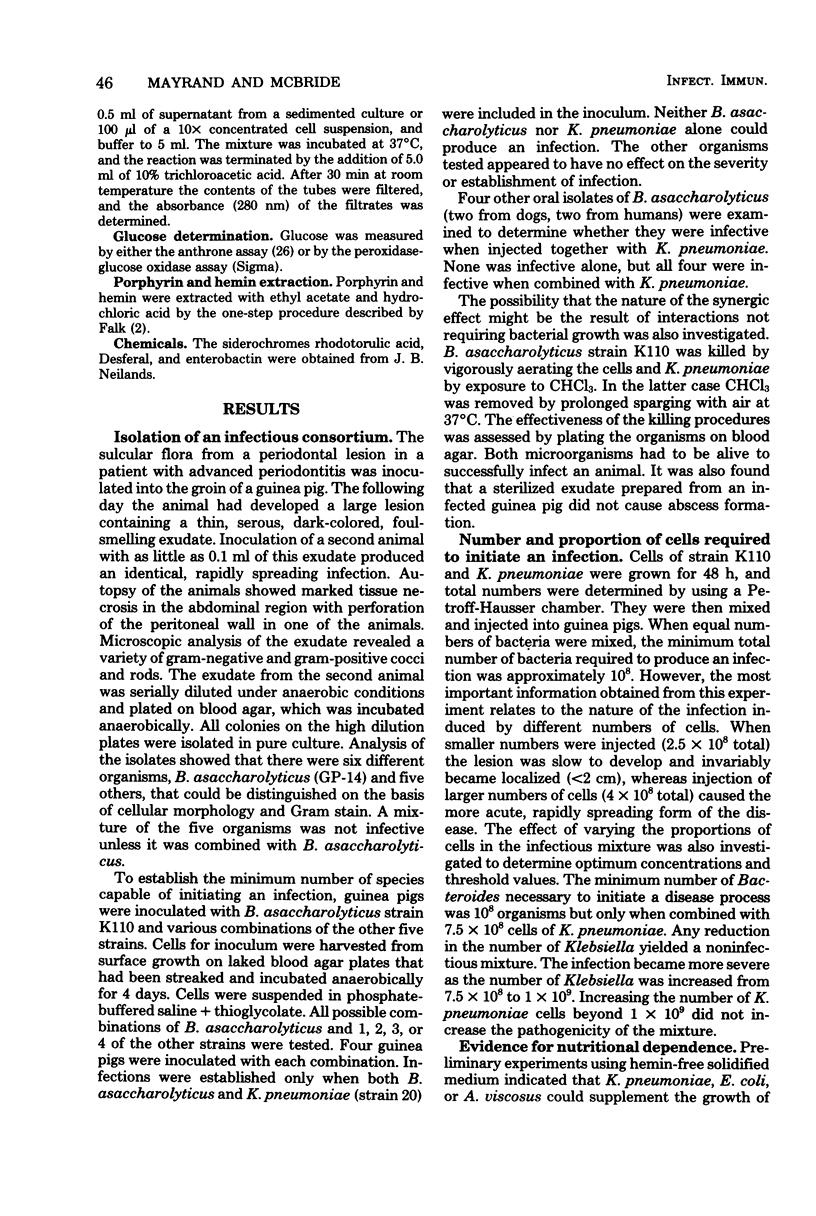

Selected References
These references are in PubMed. This may not be the complete list of references from this article.
- GIBBONS R. J., MACDONALD J. B. Degradation of collagenous substrates by Bacteroides melaninogenicus. J Bacteriol. 1961 Apr;81:614–621. doi: 10.1128/jb.81.4.614-621.1961. [DOI] [PMC free article] [PubMed] [Google Scholar]
- GIBBONS R. J., MACDONALD J. B. Hemin and vitamin K compounds as required factors for the cultivation of certain strains of Bacteroides melaninogenicus. J Bacteriol. 1960 Aug;80:164–170. doi: 10.1128/jb.80.2.164-170.1960. [DOI] [PMC free article] [PubMed] [Google Scholar]
- Gisslow M. T., McBride B. C. A rapid sensitive collagenase assay. Anal Biochem. 1975 Sep;68(1):70–78. doi: 10.1016/0003-2697(75)90680-6. [DOI] [PubMed] [Google Scholar]
- Hill G. B., Osterhout S., Pratt P. C. Liver abscess production by non-spore-forming anaerobic bacteria in a mouse model. Infect Immun. 1974 Mar;9(3):599–603. doi: 10.1128/iai.9.3.599-603.1974. [DOI] [PMC free article] [PubMed] [Google Scholar]
- Lev M., Keudell K. C., Milford A. F. Succinate as a growth factor for Bacteroides melaninogenicus. J Bacteriol. 1971 Oct;108(1):175–178. doi: 10.1128/jb.108.1.175-178.1971. [DOI] [PMC free article] [PubMed] [Google Scholar]
- MACDONALD J. B., GIBBONS R. J. The relationship of indigenous bacteria to periodontal disease. J Dent Res. 1962 Jan-Feb;41:320–326. doi: 10.1177/00220345620410014201. [DOI] [PubMed] [Google Scholar]
- MACDONALD J. B., SUTTON R. M., KNOLL M. L., MADLENER E. M., GRAINGER R. M. The pathogenic components of an experimental fusospirochetal infection. J Infect Dis. 1956 Jan-Feb;98(1):15–20. doi: 10.1093/infdis/98.1.15. [DOI] [PubMed] [Google Scholar]
- MACDONALD J. B., SUTTON R. M., KNOLL M. L. The production of fusospirochetal infections in guinea pigs with recombined pure cultures. J Infect Dis. 1954 Nov-Dec;95(3):275–284. doi: 10.1093/infdis/95.3.275. [DOI] [PubMed] [Google Scholar]
- Mayrand D. Identification of clinical isolates of selected species of Bacteroides: production of phenylacetic acid. Can J Microbiol. 1979 Aug;25(8):927–928. doi: 10.1139/m79-138. [DOI] [PubMed] [Google Scholar]
- Meleney F. L. BACTERIAL SYNERGISM IN DISEASE PROCESSES: WITH A CONFIRMATION OF THE SYNERGISTIC BACTERIAL ETIOLOGY OF A CERTAIN TYPE OF PROGRESSIVE GANGRENE OF THE ABDOMINAL WALL. Ann Surg. 1931 Dec;94(6):961–981. doi: 10.1097/00000658-193112000-00001. [DOI] [PMC free article] [PubMed] [Google Scholar]
- Onderdonk A. B., Bartlett J. G., Louie T., Sullivan-Seigler N., Gorbach S. L. Microbial synergy in experimental intra-abdominal abscess. Infect Immun. 1976 Jan;13(1):22–26. doi: 10.1128/iai.13.1.22-26.1976. [DOI] [PMC free article] [PubMed] [Google Scholar]
- Roberts D. S. Synergic mechanisms in certain mixed infections. J Infect Dis. 1969 Dec;120(6):720–724. doi: 10.1093/infdis/120.6.720. [DOI] [PubMed] [Google Scholar]
- SOCRANSKY S. S., GIBBONS R. J. REQUIRED ROLE OF BACTEROIDES MELANINOGENICUS IN MIXED ANAEROBIC INFECTIONS. J Infect Dis. 1965 Jun;115:247–253. doi: 10.1093/infdis/115.3.247. [DOI] [PubMed] [Google Scholar]
- Slots J., Hausmann E. Longitudinal study of experimentally induced periodontal disease in Macaca arctoides: relationship between microflora and alveolar bone loss. Infect Immun. 1979 Feb;23(2):260–269. doi: 10.1128/iai.23.2.260-269.1979. [DOI] [PMC free article] [PubMed] [Google Scholar]
- Socransky S. S. Relationship of bacteria to the etiology of periodontal disease. J Dent Res. 1970 Mar-Apr;49(2):203–222. doi: 10.1177/00220345700490020401. [DOI] [PubMed] [Google Scholar]
- Stone H. H., Martin J. D., Jr Synergistic necrotizing cellulitis. Ann Surg. 1972 May;175(5):702–711. doi: 10.1097/00000658-197205000-00010. [DOI] [PMC free article] [PubMed] [Google Scholar]
- TREVELYAN W. E., HARRISON J. S. Studies on yeast metabolism. I. Fractionation and microdetermination of cell carbohydrates. Biochem J. 1952 Jan;50(3):298–303. doi: 10.1042/bj0500298. [DOI] [PMC free article] [PubMed] [Google Scholar]
- Takazoe I., Nakamura T. Experimental mixed infection by human gingival crevice material. Bull Tokyo Dent Coll. 1971 May;12(2):85–93. [PubMed] [Google Scholar]
- Takazoe I., Nakamura T., Homma T., Yamamoto A., Hashimoto Y. Growth promoting effect of corynebacterium upon bacteroides. Bull Tokyo Dent Coll. 1971 May;12(2):95–97. [PubMed] [Google Scholar]


